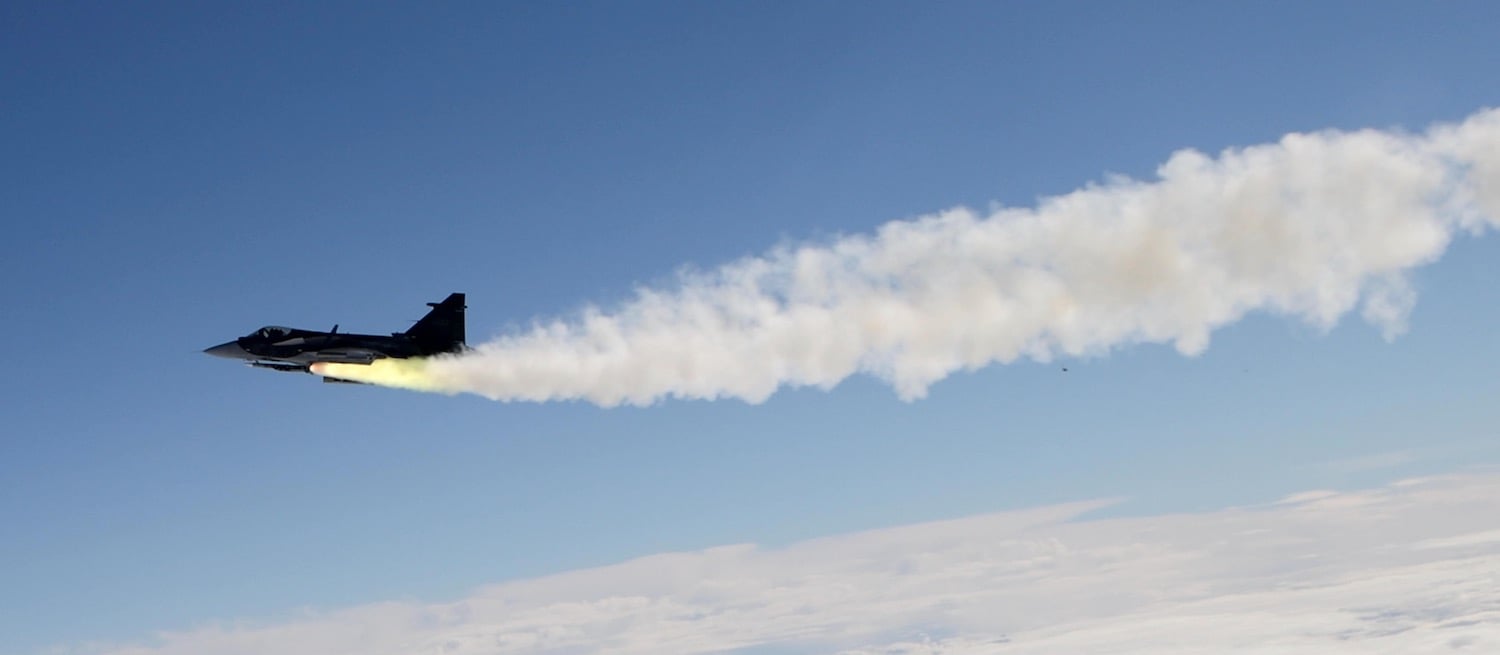Click Here to View This Page on Production Frontend
Click Here to Export Node Content
Click Here to View Printer-Friendly Version (Raw Backend)
Note: front-end display has links to styled print versions.
Content Node ID: 408460
Saab has completed all flight tests necessary for military type certification (MTC) for the JAS 39E/F-39E Gripen E fighter in the air-to-air role. The approval will allow the air forces of both Brazil and Sweden to become official operators of the type, a status currently held exclusively by Saab. Further trials will be conducted to clear the aircraft for air-to-surface roles.
Among the most recent tests was the all-important demonstration of an end-to-end firing of the MBDA Meteor long-range air-to-air missile, which will be the Gripen E’s primary air defense weapon. Taking place around the end of May/early June, the firing was conducted at the Vidsel range in northern Sweden, and involved a launch from round 16,500 feet altitude against an aerial target. The launch aircraft was the second series production machine, 6002, which fired a Meteor round equipped with telemetry systems and a command destruction capability.

With more than 30 aircraft at various stages of production, there are currently 14 Gripen Es flying on test duties—including the three prototypes—at three operating locations: Saab’s Linköping factory airfield in Sweden, FMV’s test center at nearby Malmen, and with the flight test center established at Gavião Peixoto in Brazil. The centers are linked so that data can be shared across the test fleet. Unlike in traditional programs, the functions of developmental and operational test and evaluation are intermingled where possible to maximize the benefits of flight time.
The Gripen E’s unique segregated avionics architecture allows the upgrading of mission systems without affecting flight-critical functions, in turn allowing development to proceed rapidly and iteratively, and concurrently across test aircraft and rigs in both countries. Johan Segertoft, Saab’s vice president and head of business unit Gripen Design, commented that new software releases were being test-flown every four weeks on average.
Brazil is pursuing an aggressive path to service entry, taking the lion’s share of early deliveries from Saab—which is building the first 13 of Brazil's single-seaters—and with support equipment deliveries and pilot training now under way. The air force hopes to begin operations at Anápolis air base before the end of the year. For Sweden the aim is to ramp up the operational test effort at Malmen during 2023 in anticipation of a January 1, 2025 service entry date with F7 wing at Såtenäs. The air force is reviving a combat wing (F16) at Uppsala, where a first squadron is expected to form in 2025. How the new JAS 39Es integrate into the force structure alongside the existing C/Ds has not been disclosed, but is likely to result in mixed wings operating squadrons of both Gripen generations.
Brazil originally ordered 36 F-39E/Fs, but raised that number to 40 in April. Unlike Sweden, the country is buying the two-seat F-39F, and is leading development of the version. Construction of the prototype is currently under way in Brazil. Sweden’s JAS 39E requirement remains at 60, but is expected to increase in the light of heightened tensions in Europe following Russia's invasion of Ukraine.
Those tensions have also resulted in Sweden electing to retain a significant portion of its JAS 39C/D fleet, which currently numbers 92 aircraft and which was originally planned for retirement in 2025/26. A defense white paper is due to be published next year that is expected to add more detail, but—according to air force chief Major-General Carl-Johan Edström—the retention of between 40 and 60 C/Ds is likely for service until around 2035. In order to maintain the C/D’s relevance until that time, remarked Edström, two or three major block upgrades would be required, likely to include an AESA radar and new weapons. He also noted that the JAS 39D two-seaters would not be needed for training for the JAS 39E fleet, with aircrew progressing direct to the fighter from the advanced training syllabus. Sweden is currently examining options for the latter, including the conduct of training overseas or in partnership with other Nordic—and soon-to-be fellow NATO—nations, such as Finland and Norway.
Joining NATO will be a sizeable challenge for Sweden, but having held Partner status since May 1994 the nation has been a significant contributor to alliance operations, and is a regular participant in both international exercises such as Red Flag and exercises on a more regional level with neighboring NATO air arms.
For NATO the addition of the Swedish air force brings with it a significant addition of “combat mass” in a tense region of Europe, and also some unique proficiencies. General James Hecker, commander of U.S. Air Forces Europe and Allied Air Command, noted while speaking to reporters at Uppsala this month that NATO was particularly interested in learning more about Sweden’s acknowledged expertise in dispersed operations at a time when such concepts were becoming increasingly relevant in the light of Ukrainian experiences.